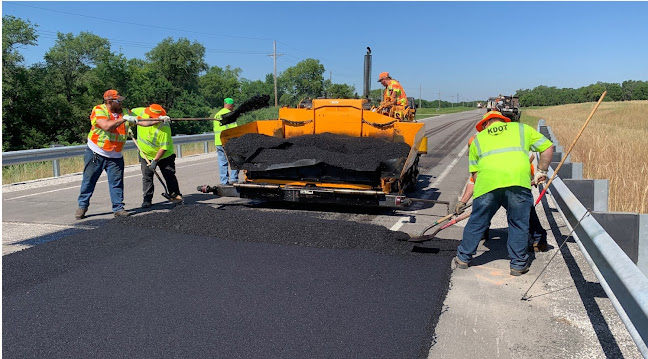By Tim Potter,
District Five Public Affairs Manager
Imagine this: You’re under a blinding
sun along U.S. 50 near the town of Walton, and the combined heat and humidity
makes it feel like around 106 degrees. It’s suffocatingly hot, the kind of
conditions that trigger a heat advisory.
Not just that: You’re laying
down asphalt cooking at around 250 degrees when you first apply it. The stiff
south wind feels like more of a blast furnace than a cooling breeze. You’ve
worked through lunch because overlaying a side road at a highway is one of
those jobs where it’s not real practical to take a normal 30-minute break. The
equipment has been strategically positioned, and the different tasks involved
must click right along. The asphalt -- and the process for applying, shaping
and finishing it -- is demanding, unforgiving.
That is what it was like for a
combined team of crew members – from the Newton Subarea, District Special Crew
and El Dorado Area and El Dorado Subarea -- the afternoon of July 28. If you
had to visit one of the hottest KDOT jobs on an extra sweltering day, this was
it. They had been overlaying side roads for almost two weeks.
Sweat beads covered the
reddened face of Bobby Jones that afternoon as he matter-of-factly explained
the work being done and the reality of enduring merciless weather.
“The hotter it is, the nicer
it lays,” Jones said of the asphalt. “You have to work it while the asphalt’s
hot.” The Newton Subarea Supervisor watched a massive roller compact the new
surface. Even though they had paving machines, some of the finishing and
clean-up tasks must be done by hand, by bending over a shovel and pushing and
lifting.
Through it all, “You have to
drink lots of fluids; otherwise, you’ll be laid out on top of the asphalt,”
Jones said. “If you don’t keep hydrating, this heat will take it right out of
you in a heartbeat.”
Everyone had a different role
in the overlay job, and part of it was paying attention to their co-workers –
operators making sure they didn’t drive over someone, everyone staying aware of
the semis barreling past only feet away, everyone making sure that the next
person wasn’t overcome by the heat.
“This is a team effort,” Jones
said. “We all have to watch out for each other.”

